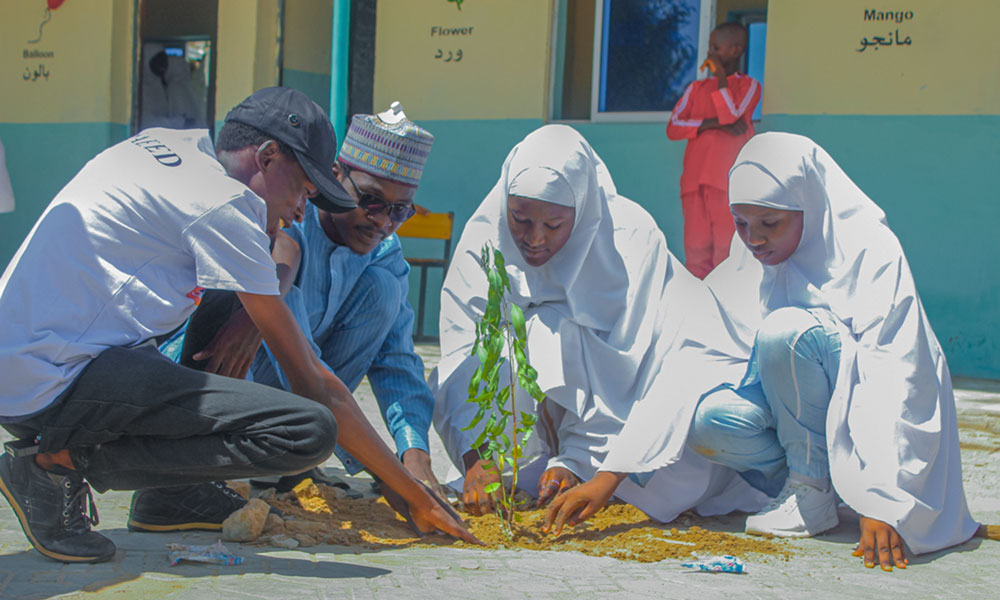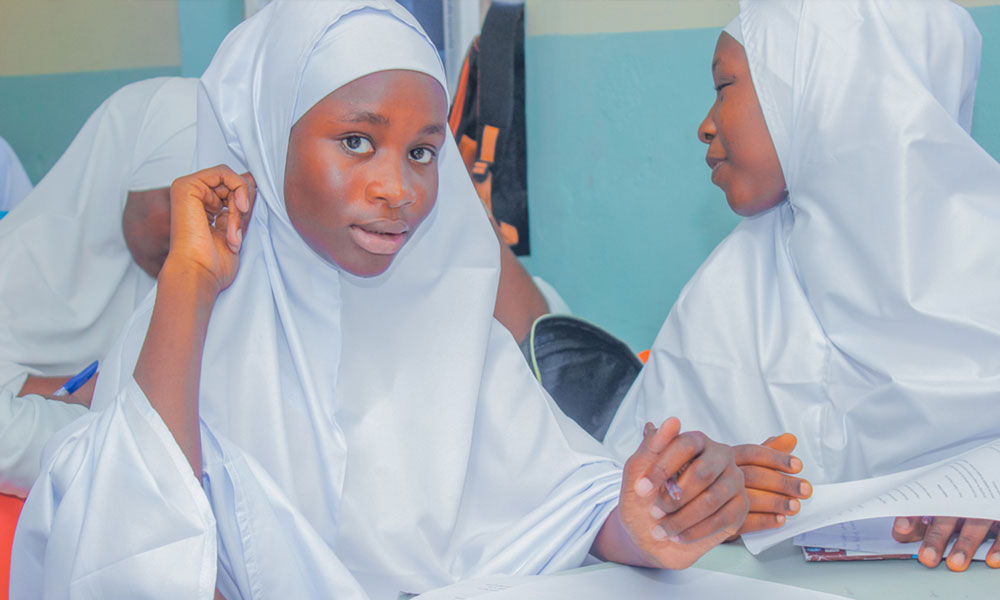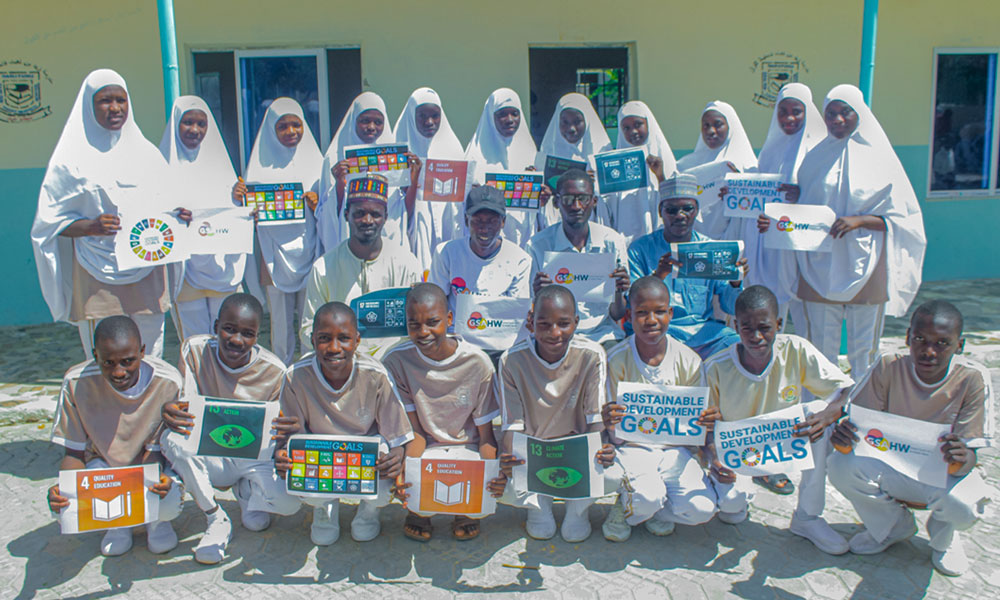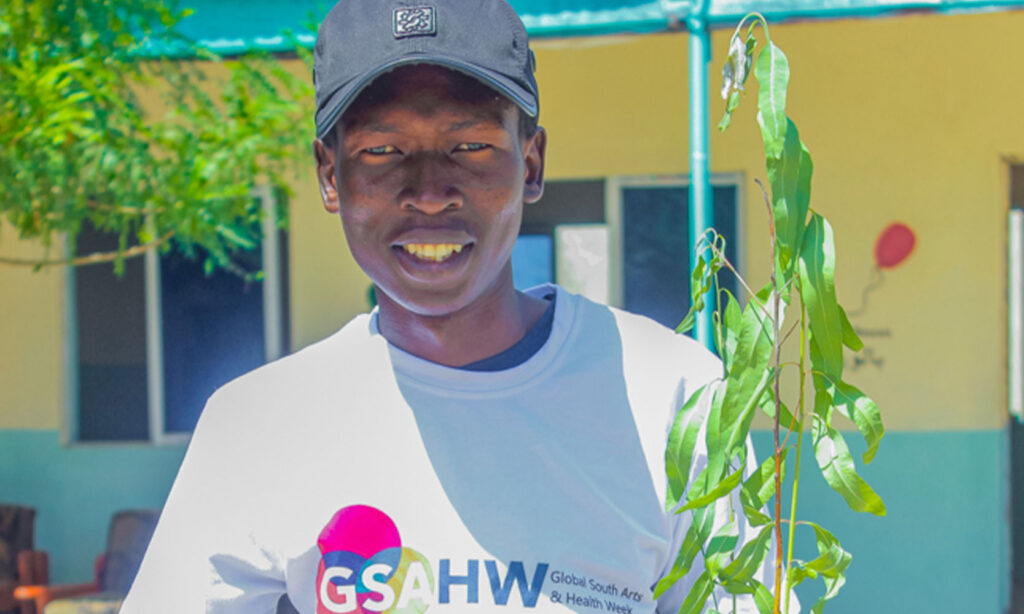



"These films increased my understanding of the issue's importance and inspired me to take proactive steps to address it. They emphasized the importance of empowering young people to take action and the fact that real change begins at the grassroots level. This shift in perspective inspired me to launch my project, "Growing Together: Trees and Dreams," which aims to address these issues by educating and engaging students in climate action and environmental conservation."
— Saeed Muhammad Lawan
Saeed Muhammad Lawan is a student at Yobe State University in Potiskum, Yobe State, Nigeria. For the SIMA Student Changemaker Award, Saeed Muhammad Lawan chose to screen What About Our Future?
What About Our Future? chronicles the “Sustainabiliteens,” a group of young environmental activists who organized the largest strike in Vancouver’s history. The film takes a unique look into the movement while the youth organize protests, pressure politicians and educate younger teens about environmental justice.
Through the film, Saeed Muhammad Lawan encouraged his fellow students and community members to connect with Sustainable Development Goal (SDG) Number 14: Life Below Water and SDG 15: Life on Land.
Saeed Muhammad Lawan was the winner of the 2023 SIMA Student Changemaker Award.
The Project Description:
Growing Together: Trees and Dreams is an award-winning project that serves as a beacon of hope and environmental change in the face of adversity. This remarkable initiative addresses these pressing issues through a multifaceted approach in a community where seasonal droughts, flooding, strong winds, diseases, and deforestation have taken a toll on the local ecosystem.
The primary goal of the project is to plant trees in a community secondary school. This initiative aims to combat deforestation, promote environmentally sustainable practices, and create a greener future. Students are not only educated about climate change and nature-based adaptation during the campaign, but they are also deeply engaged in a poetry writing workshop that encourages them to express their feelings about the planet.
The impact of over 200 trees planted on school grounds is already visible, bringing new life to the environment. Each student is given a tree seedling to care for at home, symbolizing their commitment to the environment. These young trees serve as a powerful reminder that their dreams and the well-being of the planet are inextricably linked.
This outstanding project is a powerful response to the community’s challenges, demonstrating how a small group of committed individuals can make a significant difference. Growing Together: Trees and Dreams is about more than just planting trees; it’s about fostering dreams and environmental stewardship in the face of adversity.
What is the topic, theme, SDG or social issue your project addresses?
Growing Together: it focuses on environmental sustainability, tackling deforestation and promoting climate change adaptation, creative expression. It addresses the following SDGs 14, 15.
What SIMA Academy film(s) inspired your project?
What About Our Future?
What did you learn from the film(s)? Did your perspective about the issue change or did you discover something new?
I learned from the documentary “What About Our Future?” and other similar films that climate change is more than just an environmental issue; it is a serious threat to our collective future. These films provided a comprehensive view of the devastating effects of climate change, such as seasonal droughts, flooding, strong winds, diseases, and deforestation, which disproportionately affect vulnerable communities. They emphasized the urgency of action, emphasizing the importance of our youth as change agents.
These films not only increased my understanding of the importance of the issue but also inspired me to take proactive steps to address it. They emphasized the importance of empowering young people to take action and the fact that real change begins at the grassroots level. This shift in perspective inspired me to launch my project, “Growing Together: Trees and Dreams,” which aims to address these issues by educating and engaging students in climate action and environmental conservation.
To summarize, the films changed my perspective, emphasizing the importance of immediate action on climate change and the critical role of youth in driving meaningful change.
What type of project did you create?
Dialogue + Discussion, Conservation Project, Community or Coalition Building
What planning resources did you utilize to create your project. Please describe and/or share a link.
To create my project, “Growing Together: Trees and Dreams,” I used a variety of planning resources that were critical to its success. These resources included:
Research and Data: I conducted extensive research on the specific environmental challenges that my community faces, such as seasonal droughts, flooding, strong winds, diseases, and deforestation. Understanding the local context was critical for developing effective solutions.
I created educational materials about climate change, nature-based adaptation, and the importance of tree planting. These materials were tailored to the age and understanding of the secondary school students I was working with.
Planting Tools: I obtained the tools and equipment required for tree planting, such as shovels, saplings, watering cans, and protective gear. This ensured that the tree-planting procedure was both efficient and secure.
Workshop Facilitation: I created a curriculum for the poetry writing workshop in order to elicit students’ emotions about the environment and connect them to the significance of their actions. Writing prompts, guidance, and examples were included in this curriculum.
Partnerships: I formed alliances with local nurseries and environmental organizations to obtain tree saplings and expert knowledge about tree planting and care.
Community Engagement Plan: I developed a community engagement plan in order to involve the students’ families and the larger community in the project. This strategy included methods for encouraging students to plant more trees at home.
I created posters, flyers, and social media content to raise awareness about the project in the community and among potential supporters.
Logistical Planning: I meticulously planned the logistics of the tree planting event, taking into account factors such as the best time for planting, material transportation, and safety precautions.
Budgeting and Fundraising: I created a budget to estimate the project’s costs and began fundraising efforts to secure the funds needed. This included approaching local businesses, community members, and crowdfunding platforms for assistance.
Please tell us about the impact of your project. You can use both quantitative and qualitative outcomes.
My project, “Growing Together: Trees and Dreams,” had a significant quantitative and qualitative impact. We planted over 200 trees at the community secondary school, resulting in a noticeable increase in the local tree population. This numerical achievement is consistent with the goal of reducing deforestation and improving environmental resilience. Furthermore, by providing tree samples to each student to plant at home, we expanded the impact beyond the school, contributing to tree planting in a variety of residential areas.
The project has had a significant impact on the students and the community on a qualitative level. Students gained a better understanding of climate change, nature-based adaptation, and the value of trees as a result of the educational component. Students were inspired to express their feelings and thoughts about the planet during the poetry writing workshop, which was a creative approach to connecting them emotionally to environmental issues. This not only increased their creativity but also made them more aware of environmental issues. Their poems reflected their growing environmental consciousness and emotional attachment to trees.
The project’s influence spanned the entire community. Families of students who took part in the program were encouraged to plant trees in their yards, fostering a culture of tree planting and environmental stewardship. This level of community involvement promotes long-term sustainability and adds to environmental resilience.
The project represents a proactive response to the community’s seasonal droughts, flooding, strong winds, diseases, and deforestation. The planted trees are expected to provide numerous benefits, including improved local climate, soil erosion protection, and improved air quality.
The project’s overall impact can be seen in the increased tree population, students’ increased awareness and emotional connection to environmental issues, and the community’s collective efforts toward environmental improvement. By addressing these critical issues, the project has set a positive course for a more resilient and sustainable community.
Please tell us what you learned in the process of creating your project?
The process of creating the “Growing Together: Trees and Dreams” project was eye-opening and educational. First and foremost, I discovered the importance of education and emotional connection in increasing environmental awareness and action. I saw how providing knowledge and evoking emotions could inspire individuals, particularly students, to participate actively in environmental initiatives through the educational component and the poetry writing workshop. It emphasized the importance of awareness and emotional investment in driving positive change.
Second, I learned about the importance of community involvement. It was critical to encourage not only students but also their families to plant trees at their homes in order to broaden the project’s impact. This approach emphasized the significance of involving communities in environmental initiatives because it fosters a sense of shared responsibility and commitment to sustainability.
Furthermore, the project reinforced the idea of starting small to achieve big results. Planting over 200 trees and distributing tree samples may appear insignificant, but it represents a tangible step toward addressing deforestation and improving environmental resilience. The project’s success demonstrated that even small-scale efforts can contribute to larger-scale environmental goals.
I also learned the significance of adaptability and community-specific solutions. The project’s objectives were guided by an understanding of the community’s challenges, which included seasonal droughts, flooding, strong winds, diseases, and deforestation. This experience demonstrated the importance of tailoring environmental initiatives to a community’s specific needs and conditions in order to ensure relevance and effectiveness.
Tell us about 1 thing you will do differently in the future after learning about this social issue and creating your own project about it.
One significant change I intend to make in future projects after learning about the social issue of environmental degradation and creating “Growing Together: Trees and Dreams” is to include more extensive research and assessments tailored to the specific needs and conditions of the communities I hope to serve. This project emphasized the importance of understanding a community’s unique challenges, environmental conditions, and socioeconomic factors.
In the future, I plan to conduct thorough environmental assessments and meet with community members in person to gain a better understanding of their concerns and goals. This approach will aid in the development of more effective, community-specific solutions to their most pressing problems. It will also ensure that the projects are long-term and in line with the community’s goals.
In addition, I intend to seek partnerships and collaborations with local experts and organizations in order to leverage their knowledge and resources. I can create a more comprehensive and impactful response to environmental issues by involving community stakeholders and experts. The “Growing Together: Trees and Dreams” project has reinforced the importance of community-driven and community-tailored initiatives, and I am committed to enhancing these aspects in my future work to achieve long-term positive change.